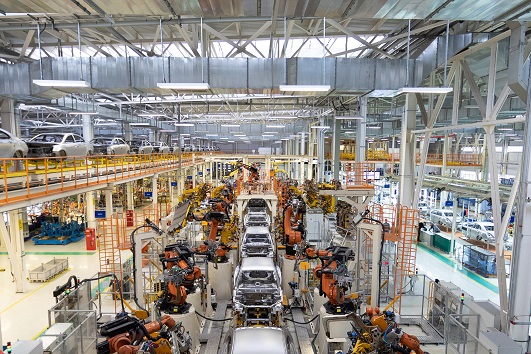 Automated construction based on principles already established in sectors like automotive, combined with emerging digital tools, could have a transformative effect on construction. Jaimie Johnston, director and head of global systems at Bryden Wood, takes a look
Automated construction based on principles already established in sectors like automotive, combined with emerging digital tools, could have a transformative effect on construction. Jaimie Johnston, director and head of global systems at Bryden Wood, takes a look
Radical change is coming to construction and, as with so many other industries, it is technology that will enable it.
Just as the iPhone disrupted mobile communications and created the ‘app economy’, Netflix changed TV and IKEA furniture, our industry will be disrupted by automation.
A fresh approach will create a network effect and exponential adoption. We’re not talking about sci-fi gadgetry but a new kind of construction where digital design tools inform building, rather like manufacturing. Let’s not imagine a “robot builder” laying bricks more quickly or drilling hard-to-reach holes, but designing out the holes or building the wall in a different way.
We’re calling this automated construction. By applying modern manufacturing approaches, it can boost productivity and reduce waste by as much as 90%. There are three key elements: platforms, digital tools and automated assembly.
Platform construction
We all recognise that every model in a car manufacturer’s range is built on the same chassis (not that you’d guess at these shared component sets from looking at the finished cars). In this example, the car’s chassis and other components form a “platform” – hence our term “platform construction” – and the same principles can apply to construction. It doesn’t matter that construction mostly happens outdoors or that buildings are more varied than cars. There are constants that stem from the human form. Ceiling height, stair angle or distance from a window, let’s say, all fall with certain ranges whether the building is a home or a hospital. So just a few types of connector, working with beams and columns of any length, can combine to create a huge variety of structures.
This limited set of components can work across different building types and sectors, so demand is constantly high, and it makes business sense for a wide network of SMEs to manufacture them. A recent objective cost-benefit analysis showed a 33% reduction in capital cost, meeting the government’s Construction 2025 strategy targets. There’s more on the platform approach to construction in three books published by Bryden Wood.
Digitally enabled workflows
As with manufacturing, platform construction is driven by data. Naturally, this includes BIM, which is vital for processing informational content and structure, but we need to move beyond it and use other digital tools. New generative design, algorithmic simulation, geospatial analysis and VR/AR are all increasingly important, not just in accelerating the design process but also in increasing the “search area” for ideas. More possible solutions mean better solutions.
A platform approach fits logically with these advanced digital techniques. And machine learning, for example, can understand the components of a platform system and evolve them to generate ever-more efficient solutions.
At Bryden Wood, we use BIM as part of a wider digital capability. Alongside BIM content creators, we have experts in mathematical modelling, virtual prototyping and discrete event simulation, as well as teams who create client specific apps and advanced digital workflows. We’re currently creating these for Highways England, the Greater London Assembly and the Education & Skills Funding Agency.
Automated assembly
Digital tools enable design for assembly, which makes it easier, faster and safer to put a building together on site. Far fewer tower crane movements are required, for example, and with each one averaging 20 minutes per lift, the time savings are obvious.
Just as importantly, design for assembly means that workers can be effective after relatively short periods of training. This offers employment to new groups and a solution to the looming skills crisis.
A new creative freedom
Automated construction has the ability to free architects and designers from dull, repetitive tasks so that they can contribute creatively through ideas and placemaking. This is where their input has most value yet, ironically, they currently spend 80% of their time on documentation. So there’s the potential to unlock creativity and push back the boundaries of what is possible.
Increasing support from government
Our work has been highly influential on government thinking and policy. A series of announcements and initiatives show increasing support for a platform approach with increasing levels of detail, as the timeline shows. The recently launched Proposal for a New Approach to Building: Call for Evidence describes a platform approach to design for manufacture and assembly or “P-DfMA” as “currently the most promising trend in the construction and engineering sector”.
The government has £600bn of investment in the pipeline for the next decade, and a responsibility to spend it effectively. It looks as if this will provide the critical mass that automated construction needs to disrupt the industry and drive exponential adoption. Ultimately, it’s about enough of us seeing things the same way and, if we do, the future looks bright.
Jaimie will be exploring automated construction in further detail at his talk at BIM Show Live 2019 on Wednesday 27 February at 11:15: Disruption is almost inevitable; the question is, how we as an industry choose to respond.
 Jaimie Johnston
Jaimie Johnston
Director and Head of Global Systems
Bryden Wood
Tel: +44 (0)20 7253 4772
Twitter: @BrydenWood
LinkedIn: Brydenwood limited
Youtube: Bryden Wood
















